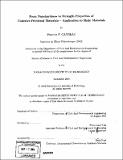| dc.contributor.advisor | Franz-Josef Ulm. | en_US |
| dc.contributor.author | Ganneau, Francois P., 1979- | en_US |
| dc.contributor.other | Massachusetts Institute of Technology. Dept. of Civil and Environmental Engineering. | en_US |
| dc.date.accessioned | 2005-09-27T17:23:22Z | |
| dc.date.available | 2005-09-27T17:23:22Z | |
| dc.date.copyright | 2004 | en_US |
| dc.date.issued | 2004 | en_US |
| dc.identifier.uri | http://hdl.handle.net/1721.1/28626 | |
| dc.description | Thesis (S.M.)--Massachusetts Institute of Technology, Dept. of Civil and Environmental Engineering, 2004. | en_US |
| dc.description | Includes bibliographical references (p. 213-221). | en_US |
| dc.description.abstract | Advanced experimental and theoretical micromechanics such as nanoindentation makes it possible today to break down highly heterogeneous materials to the scale where physical chemistry meets (continuum) mechanics, to extract intrinsic material properties that do not change from one material to another, and to upscale the intrinsic material behavior from the sub-microscale to the macroscale. While well established for elastic properties, the extraction of strength properties of cohesive-frictional materials from nanoindentation tests has not been investigated in the same depth. The focus of this thesis is to investigate in depth the link between nanohardness of cohesive-frictional materials and strength properties. To address our objectives, we develop a rational methodology based on limit analysis theorems and implement this methodology in a finite element, based computational environment. By applying this technique to indentation analysis, we show that it is possible to extract the cohesion and the friction angle from two conical indentation tests having different apex angles. The methodology is validated on a model cohesive-frictional material, bulk metallic glass, and a first application to a highly heterogeneous natural composite material, shale materials, is shown. The results are important in particular for the Oil and Gas industry, for which the reduced strength properties (cohesion and friction angle) are critical for the success of drilling operations. | en_US |
| dc.description.statementofresponsibility | by Francois P. Ganneau. | en_US |
| dc.format.extent | 221 p. | en_US |
| dc.format.extent | 9290986 bytes | |
| dc.format.extent | 9318273 bytes | |
| dc.format.mimetype | application/pdf | |
| dc.format.mimetype | application/pdf | |
| dc.language.iso | en_US | |
| dc.publisher | Massachusetts Institute of Technology | en_US |
| dc.rights | M.I.T. theses are protected by copyright. They may be viewed from this source for any purpose, but reproduction or distribution in any format is prohibited without written permission. See provided URL for inquiries about permission. | en_US |
| dc.rights.uri | http://dspace.mit.edu/handle/1721.1/7582 | |
| dc.subject | Civil and Environmental Engineering. | en_US |
| dc.title | From nanohardness to strength properties of cohesive-frictional materials : application to shale materials | en_US |
| dc.type | Thesis | en_US |
| dc.description.degree | S.M. | en_US |
| dc.contributor.department | Massachusetts Institute of Technology. Department of Civil and Environmental Engineering | |
| dc.identifier.oclc | 58917551 | en_US |
